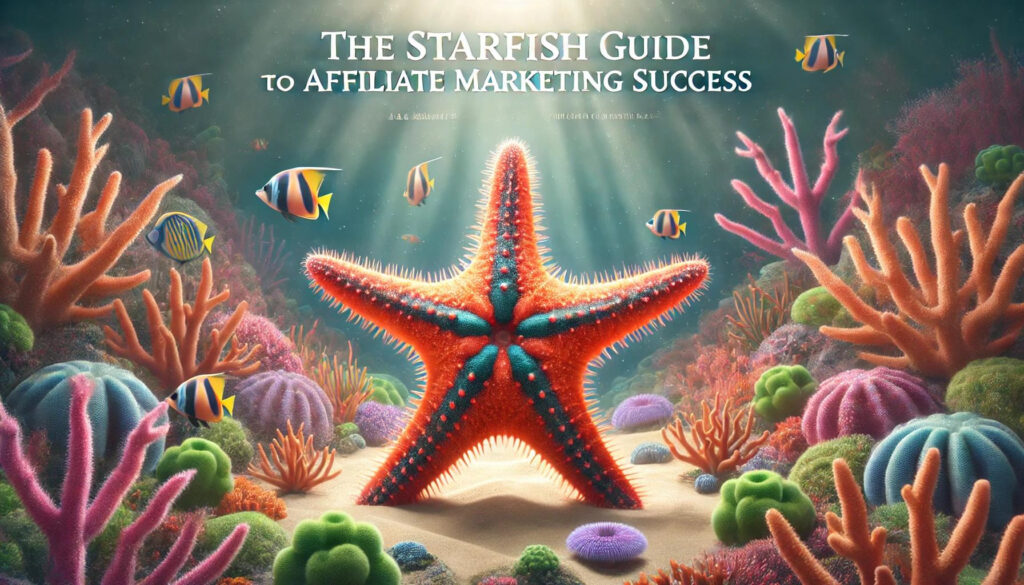Imagine this.

You’re having a rough day in your affiliate marketing journey. Maybe a campaign didn’t go as planned, and you think, “Ouch, that’s gonna hurt my numbers.” Now, picture this: what if a small effort could grow into something much bigger? Sounds like a dream, right? But for our ocean buddy, the Linckia columbiae starfish, that’s just another Tuesday. This little sea superstar can regenerate its entire body from a piece smaller than a half-inch. Yep, you heard it right. Just a tiny chunk, and voila, a brand-new starfish! It’s like the ultimate comeback story. And guess what? Affiliate marketing works the same way.
A single, well-placed link can lead to countless conversions. Lose a partner? No problem, find a new one. Late for a campaign launch? Send a quick email and start fresh. Had a bad month? Just tweak your strategy and bounce back. The possibilities are endless and rewarding. So next time you’re feeling down about a small setback, just remember the Linckia columbiae. If a tiny piece of starfish can turn into a whole new being, a small effort in your affiliate marketing can surely turn into big results. Stay resilient and keep growing like a star(fish)!
Introduction: Embracing the Starfish Resilience in Affiliate Marketing
Affiliate marketing is a dynamic field where flexibility, persistence, and strategic thinking are paramount. Just like the Linckia columbiae starfish, affiliate marketers need to embrace the power of regeneration and resilience. Every setback is an opportunity to learn, adjust, and come back stronger. In this blog post, we’ll delve into essential strategies that can help you increase conversions, select profitable niches, and leverage social media for promotions, ensuring your affiliate marketing efforts thrive even after challenges.
Strategy #1: Increasing Conversions with Well-Placed Links
The key to success in affiliate marketing lies in understanding your audience and strategically placing your affiliate links. Think of each link as a potential starfish arm—capable of growing into a significant revenue source with the right nurturing. Here’s how you can do it:
- Know Your Audience: Conduct thorough research to understand the needs, preferences, and behaviors of your target audience. Tailor your Content to address their pain points and offer solutions through your affiliate links.
- Content Quality: Ensure your Content is informative, engaging, and relevant. High-quality Content builds trust with your audience, making them more likely to click on your affiliate links and make a purchase.
- Placement and Context: Strategically place your affiliate links within your Content where they make the most sense. Avoid cluttering your posts with too many links; instead, focus on contextual placements that naturally lead to conversions.
- Call-to-Action (CTA): Use compelling CTAs that guide your audience towards taking action. Phrases like “Learn more,” “Get the best deal,” or “Discover how” can encourage clicks.
Strategy #2: Selecting Profitable Niches
Choosing the right niche is crucial for your affiliate marketing success. A profitable niche is one that balances your interests, audience demand, and monetization potential. Here’s a step-by-step guide to help you find your ideal niche:
- Passion and Knowledge: Select a niche that you are passionate about and have substantial knowledge in. This will make Content creation easier and more authentic.
- Market Demand: Use tools like Google Trends, Keyword Planner, and social media insights to gauge the demand for your chosen niche. Look for consistent interest and potential for growth.
- Competition Analysis: Analyze your competition to understand what works and what doesn’t. Identify gaps in the market that you can fill with unique Content or a different approach.
- Monetization Opportunities: Evaluate the affiliate programs available in your niche. Look for programs that offer good commission rates, reliable payment structures, and quality products that you can confidently promote.
Strategy #3: Leveraging Social Media for Promotions
Social media platforms are powerful tools for affiliate marketers. They provide direct access to your audience, allowing you to promote your affiliate links and drive traffic to your Content. Here’s how to effectively use social media for your affiliate marketing efforts:
- Platform Selection: Choose the platforms that best align with your audience and Content style. For instance, Instagram and Pinterest are great for visual Content, while Twitter and LinkedIn are ideal for more professional or news-oriented updates.
- Consistent Posting: Maintain a regular posting schedule to keep your audience engaged. Use a mix of Content types, including posts, stories, videos, and live sessions to keep things interesting.
- Engagement: Actively engage with your audience by responding to comments, participating in discussions, and sharing user-generated Content. Building a community around your brand can lead to higher trust and more conversions.
- Promotional Tactics: Use social media to tease your Content, offer exclusive deals, and run contests or giveaways. These tactics can boost visibility and attract more clicks on your affiliate links.
- Analytics and Optimization: Monitor your social media performance using analytics tools provided by each platform. Track metrics like engagement rates, click-through rates, and conversions to understand what works and refine your strategy accordingly.
Conclusion: The Starfish Mindset for Affiliate Marketing Success
Just like the resilient Linckia columbiae starfish, successful affiliate marketers thrive on adaptability and persistence. By strategically placing your affiliate links, choosing profitable niches, and leveraging social media, you can turn small efforts into significant rewards. Remember, every setback is an opportunity to learn and grow. Stay resilient, keep experimenting, and watch your affiliate marketing efforts flourish like a starfish regenerating in the vast ocean of possibilities.
PS: Want to take your Affiliate Marketing to the next level JOIN THE MAP REVOLUTION


